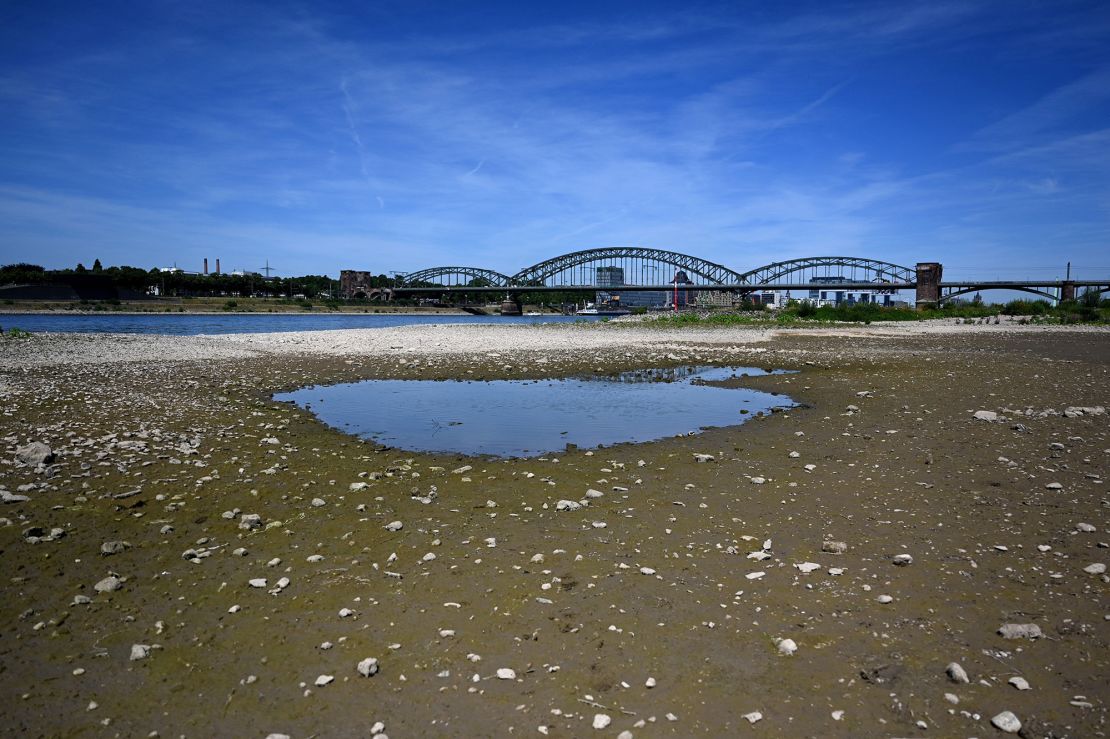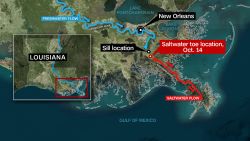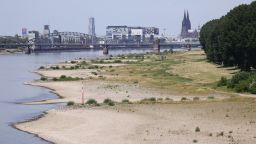Sixty-three percent of land in the European Union and United Kingdom – an area nearly the same size as India – is now under either drought warnings or alerts, according to data published by the European Drought Observatory on Wednesday.
The new figures mark a slight increase from a 10-day period earlier in July, with 46% of land now covered by “warnings,” which means there is a deficit of moisture in the soil, while 17% is under the more severe level of “alert,” where vegetation is stressed. The area is also bigger than the US’ three largest states – Alaska, Texas and California – combined.
A map accompanying the data shows a high concentration of the more severe alert level in the UK, France, Germany, Spain, Italy, Hungary and Romania.
An update on Wednesday by the UK Centre for Ecology and Hydrology suggested that warmer-than-average temperatures and lower-than-average rainfall was likely to affect the southeast of the country, mostly England, until October. Water companies in these areas are considering more hosepipe bans on millions of customers in coming weeks.
On Monday, the EU’s climate monitoring agency Copernicus said that much of Europe experienced a drier-than-average July, with several local records broken in the west for low rainfall and drought hitting several parts of southwestern and southeastern Europe.
In its monthly climate update, Copernicus said those conditions facilitated the spread and intensification of wildfires, fueled also by back-to-back heat waves in parts of Europe, in what is shaping up to be one of the continent’s hottest summers on record.
The new data comes as the world grapples with a food crisis only just abating as Russia lifts its blockade of grain exports from Ukraine. Extreme weather and supply chain issues have worsened the crisis and are likely to persist for some time.
A recent report by the Joint Research Centre, the European Commission’s science service, forecast a drop of 8-9% in the production of grain maize, sunflowers and soybeans in the EU because of hot and dry conditions over the summer, well below the five-year average.
Copernicus Senior Scientist Freja Vamborg said that “dry conditions from previous months combined with high temperatures and low precipitation rates seen in many areas during July may have adverse effects on agricultural production and other industries such as river transport and energy production.”
Months with little rain
In July, water reservoirs in several parts of Europe were at a very low levels, insufficient to sustain demand, according to Copernicus.
Southern England experienced its driest July since records began in 1836, while the month across the United Kingdom was the driest July in more than 20 years. The UK saw just 46.3mm, or 56%, of its average rainfall for the month following a long run of drier-than-average months, with the exception of February.
In France, July saw a total rainfall of 9.7mm, which made it the driest July there since records began in 1959 and represented a rainfall deficit of 85% compared to the 1991-2020 average.

Meanwhile, in Italy, a lack of rain since December 2021 has hit northern parts of the country and the Po River completely dried up in places earlier this summer. In mid-July at Cremona – around halfway along the Po – the water was more than 8 meters below “hydrographic zero,” impacting hydroenergy production, agriculture and transport.
Copernicus said the situation improved as a result of rainfall towards the end of the month, which brought a 40cm increase for the river, although hydropower production in the region was still affected.
July was also globally one of three warmest recorded, close to 0.4 degrees Celsius above the 1991-2020 average, and the sixth-hottest July in Europe, Copernicus said.
Spain, France and the United Kingdom experienced at least one day over 40 degrees Celsius last month. In the UK, temperatures climbed to over over 40 degrees Celsius (104.5 degrees Fahrenheit) on July 19 with the English village of Coningsby recording 40.3C for the first time ever.
Meanwhile, Spain reported its hottest July in over 60 years on Monday.
“July 2022 has been extremely hot in Spain, the warmest since at least 1961, with an average temperature of 25.6 ºC [78.1 Fahrenheit], which is 2.7 ºC [4.9 Fahrenheit] higher than the normal average,” the country’s national weather agency AEMET said in a post on Twitter. July was “0.2 ºC [0.4 Fahrenheit] higher than that of July 2015, which until now was the warmest month of July,” it added.
CNN’s Benjamin Brown and Molly Stazicker also contributed to this report from London.























